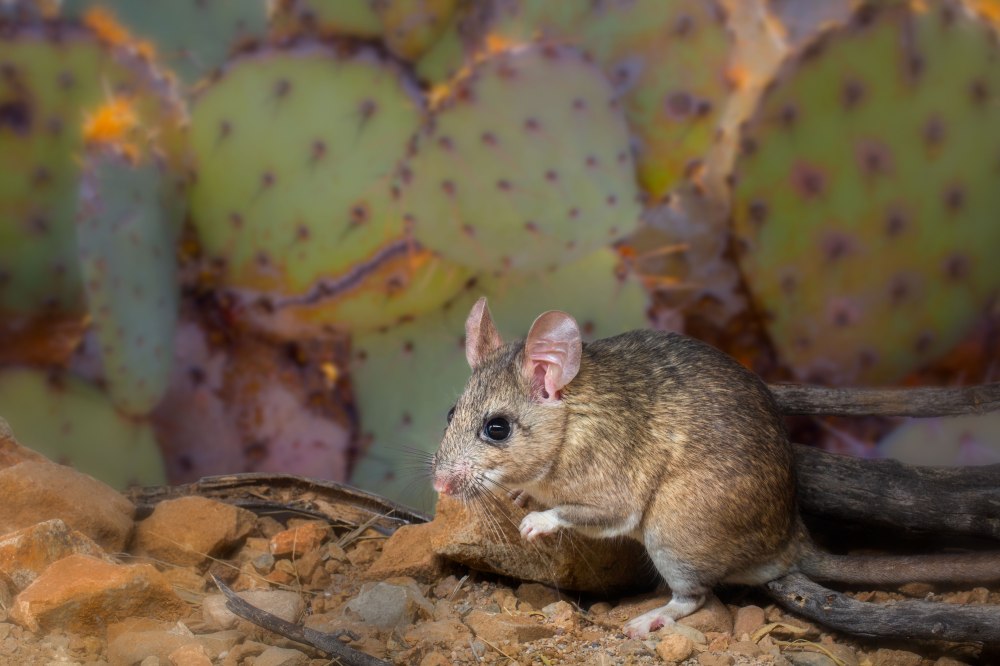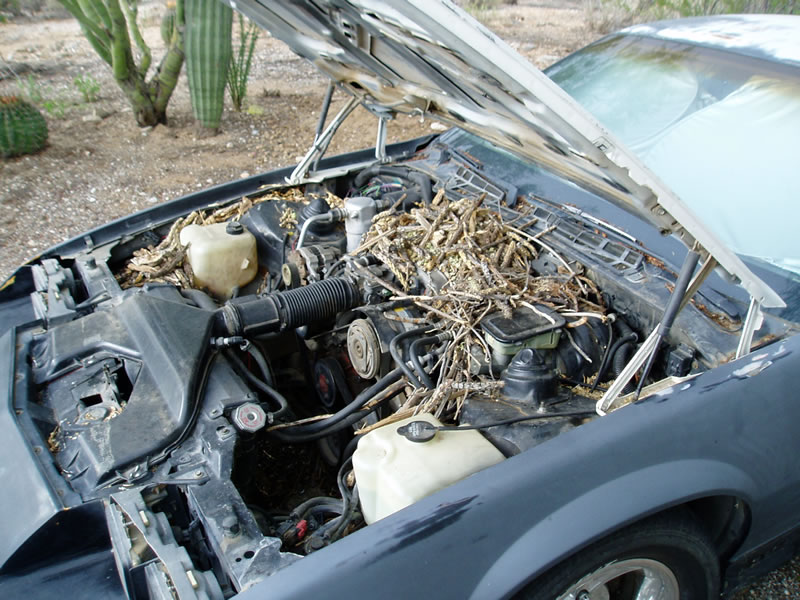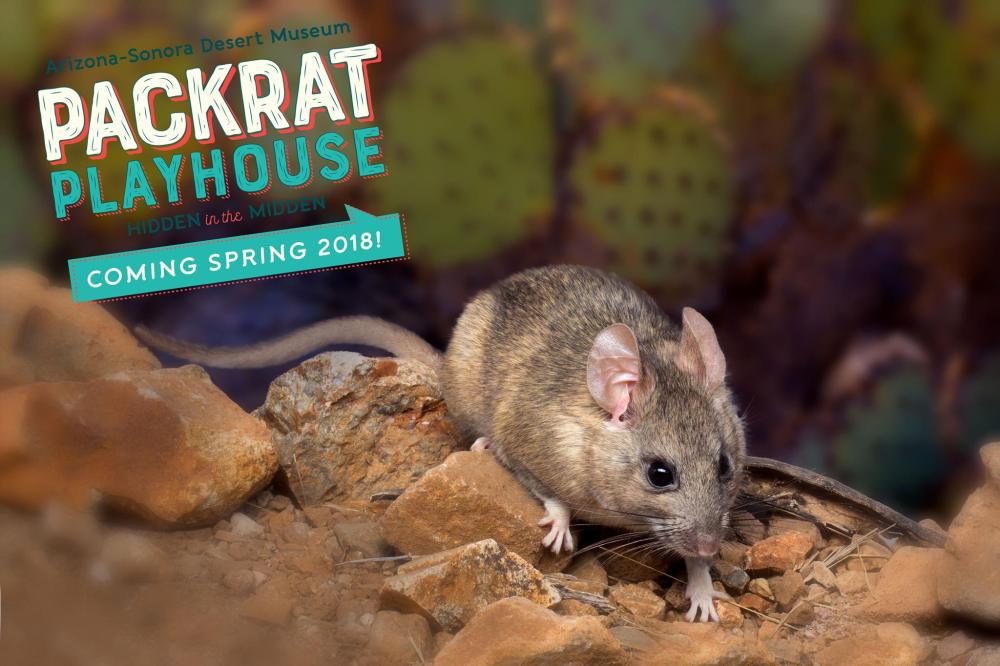Packrats are absolutely vital to a healthy desert ecosystem.
Packrats eat plant parts and seeds, and thus are seed and cactus dispersers (they help plants get started in new places). They not only help aerate soil, but their poop even helps fertilize the seeds!
Additionally, packrats are food for bobcats, coyotes, owls, hawks and snakes. Those animals rely on these fuzzy furballs for a full belly. Packrats are an essential part of the food web.
Room for rent! Packrat homes house other animals. Mice, arthropods (eg. insects and spiders), and even tortoises do not mind cohabitation with these rodents as their houses are climate controlled and well protected. In areas with a packrat presence, the biodiversity of animals is higher. Thus, they are considered not just ecological engineers, but a keystone species as well.

Packrats live in a…house, midden, or nest?
These amazing architects construct homes made out of sticks, branches, and rocks. They even protect it with cholla pieces and dog poop! The house has many rooms in it, including the nest (bedroom) and midden (toilet).
Some packrat houses are so well constructed and protected that they have survived and been continuously occupied for thousands of years. Wow, what workmanship!
Packrats are the original Sonoran Desert Scientists
Packrat pee is incredibly viscous and thick. When they pee on things, it ensconces them in an amber-like fluid which then crystallizes. The objects are so protected in this package that packrats unknowingly create time capsules of our past! The seeds, plant parts, animal bones, and pollen fragments that they save give us a view of bygone eras. The Sonoran Desert doesn’t have ocean sediment or ice cores to record its past, but it does have middens. So, thanks to these resourceful rodents, paloecologists know that the ecology of the American southwest has changed significantly over the last 50,000 years.
Did you know? Saguaros have only been in the Tucson region for about 8,000 years! We appreciate packrats for helping us celebrate and understand our surroundings.
Packrats are copious collectors
Packrats are also known as trade-rats due to their propensity to pick up small objects and collect them. When a packrat is carrying a prized possession and encounters another, it decides whether or not to trade in the first toy. Wildlife biologists still don’t know why packrats collect, just that they do. Soda cans, golf balls, plastic toys, car keys and more all get picked up.
Do you curate (take care of) a collection at home? What do you collect and why? Tell us in the comments! Watch the video below to see what these kids collect!
Your packrat package is undeliverable
While it’s unusual for a non-profit to refuse a donation, we kindly do not need gifts of trapped packrats. It’s impossible to know if the rodent has ingested poison, which can be transferred to our animals. Please bring your kids to see Packrat Playhouse- but leave the live animals at home!
Help! Packrats are in my car. What do I do?
While packrats play an important part of the ecosystem, we recognize that it can be mentally taxing and financially frustrating to have a packrat problem. Because they like enclosed protected spaces, packrats make homes of car engines, BBQ grills and AC units.
The Desert Museum recommends following a Personal Packrat Protocol to avoid expensive problems.
- Keep the area near your home clean and tidy to prevent packrats from moving in. Clear away brush, dismantle rock piles, clean up gardening equipment, and leave a BBQ uncovered. Regularly maintain these chores.
- Packrat poison doesn’t know which desert creatures are friend or foe. Avoid using poisons since they are not only harmful to packrats, but secondarily toxic to their predators such as bobcats and owls. Additionally, household pets can get into poison traps left in the yard.
- Removal: While wearing gloves (packrat houses are full of cactus), dismantle the house using a pitchfork or shovel. Dispose of the debris in a trash can. Watch out for snakes and scorpions as you do this! Consider permanently removing agave and prickly pear patches if packrats continue to find them comfortable homes.
- Hire a local pest control company that will live trap and relocate packrats. They can also dismantle the houses safely. While there isn’t solid data on packrat relocation and survival rates, it is a better environmental choice than using poisons.

Stay tuned for more details about our upcoming new exhibit, Packrat Playhouse: Hidden in the Midden!

Written by: Catherine Bartlett, ASDM Education Specialist
When relocating packrats you must remember they will run home over long distances. I had one on my property that was marked with a missing piece of his ear. I caught and relocated him multiple times from a couple of blocks to maybe 1/4 mile away. Even when transported in a box, unable to see, he would run back home directly across open desert. I watched him do this. I finally relocated him several miles into the local hills. I hope he survived ok. I did this with several packrats by trimming several small patches of fur. They always ran home if released only several blocks away. They are very interesting animals.
LikeLiked by 1 person
So interesting. I used to volunteer for a wildlife rehabber in Vail and raised many of these little guys when they were orphaned. Shared the article.
LikeLike
Robbing their nests of pinion nuts but leaving them enough to survive causes them to be useful to man in harvesting these tasty pinion nuts !
LikeLike
My mom has had a packrat in her garage for several years. He has not been distructive on any way. In fact.. he likes to collect her seashells from the basket and line them up!
LikeLike
I have had success protecting my car (which is left parked months at a time when we are traveling) by leaving a light on underneath and using a sonic pest repellant on a timer.
LikeLike
We put blinking light under hood, 24/7.Runs off battery. Have not had problem since.
LikeLike
Do bird feeders attract packrats? It has been suggested by a neighbor that we remove our bird feeders (approximately 30′ from their home) to help curb packrat activity
LikeLike
Hi Terri! Yes, packrats are attracted to food like birdseed, especially if it’s a consistent offering! If you want to feed birds, we recommend feeder styles that try to contain the seeds as much as possible, without getting flung on the ground. Suet feeders and hummingbird feeders are excellent choices that won’t attract packrats.
LikeLike